Liquid Perceptron (2000)
Simulation of a dynamical neural network excitable by the live video of the observer.by Hans H. Diebner and Sven Sahle

Hans H. Diebner and Sven Sahle: Liquid Perceptron. Invitation card for the exhibition in the K&S-gallery Berlin 2001. |

Hans H. Diebner and Sven Sahle: Liquid Perceptron within the scope of the exhibition "Vision: Image and Perception", Budapest Autumn Festival- Mucsarnok/Kunsthalle Budapest - C3 18 October - 17 November 2002. |
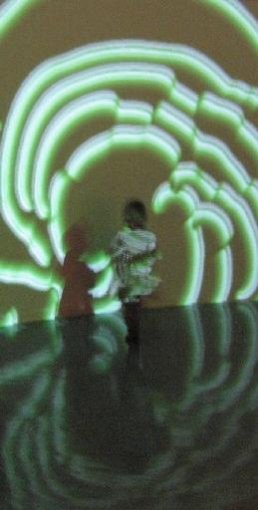
Hans H. Diebner uand Sven Sahle: Liquid Perceptron within the scope of the exhibition "Data Collision", 11 - 30 April 2008 in the town gallery Nova Gorica, Slovenia. |
Liquid Perceptron was first suggested in 2000 by Sven Sahle and developed together with him as a 2-dimensional array of coupled excitable oscillators. Liquid Perceptron 3D is the extension of the two-dimensional variant to 3 dimensions, that I developed in 2003.
The simulation of a neuronal network is excitable through the movement of the spectators. Comparable with the eye, a camera recognizes the movement of objects in space and transmits the video signal to the neuronal network which is composed of roughly half a million neurons arranged to a 2-dimensional array. Each neuron is coupled with its neighbored neurons. The activity of the neurons is color-coded. Bright areas are particularly active. One recognizes that local excitations lead to the formation of coherent patterns, comparable to the observations in visualisations of brain activity. The activity fronts spread over the whole network. The information corresponding to "perception" is represented in the global activity patterns rather than in each single neuron.
Liquid Perceptron is of course a simplified model of a neural network. The single neurons each obey a common differential equation for the modelling of of neural activity. However, the topology of their coupling is strongly simplified. Despite the fact that compared to the human brain the simulation contains almost a negligible amount of neurons, the homogeneous and purley next-neighbor coupling is far from depicting the complex connections of real neurons in the brain.
An essential idea of performative science is the inclusion of the system, which is to be modelled, into the model. In other words, in the case in hand the interaction of the observer with the installation yields at least as much new insight into the brain functioning as the simulation itself does. Of course, the context is a further crucial aspect. The relational aesthetics was particularly pronounced through the staging of the opera "Einstein on the beach" where Liquid Perceptron has been twice-included in 2001 and 2005, respectively. The installation was part of a consistent overall concept that allowed for a realization of an artistic discourse on current scientific topics. With respect to Liquid Perceptron I could well improve my understanding of synchronisation processes. In particular, the observation that the spectators tried to synchronize their movement with both the velocity of the pattern formation in the network and the musical rhythm refined my conception of self-organisation in social systems and the brain.
Hans H. Diebner und Sven Sahle: Liquid Perceptron.
Video documentation with excerpts from Einstein on the Beach, Parochialkirche Berlin 2005.
Remarks concerning pattern formation in brain and biological systems
The brain is a network that consists of 10 billion neurons. On the one hand, it works as a "stimulator" and, on the other hand, as a "simulator." Neurons can be excited through external stimuli and thereby brought to an oscillatory state. Via axons and synaptic connections these stimuli are transmitted to adjacent neurons. This leads to a global pattern formation of brain activity.
The brain remains in activity even if there is no external stimulus, which means that it simulates, for example, when we are dreaming. However the stimulator and simulator cannot be strictly treated separately. One may think of the famous deprivation tank experiments where the test persons who are fully de-coupled from external stimuli very quickly start to halluzinate. In the long term, the brain can even be seriously damaged through such a deprivation. This shows that the brain should always be systemically treated, i.e., not be described as an isolated object.
The open loop state of the simple model brain Liquid Perceptron shows wave-like fluid patterns with a low amplitude. After the network has been coupled to the external world an image of the reality becomes emergent - superimposed by the "eigen dynamics" of the Liquid Perceptron now with a pronounced amplitude.
It has first been recognized by Alan Turing that small local instabilities, perturbations or excitations, respectively, within a part of a multi-component coupled system lead to a spread of coherent global patterns throughout the total system. In his very important paper on the chemical bases of morphogenesis in 1954 he already addressed the still open question where the information is located that tells the ovum where the head and the feet, respectively, of an embryo have to be placed.

Hans H. Diebner und Sven Sahle: Liquid Perceptron und Musterbildung in biologischen Systemen in der K&S-Galerie Berlin 2001.
A further example of the same category of dynamical systems are the formations of structures in furs of animals where in the same manner so-called "Turing-instabilities" lead to global pattern formations in the total system. Compared with morphogenesis the time scale of the pattern forming processes in the brain is much smaller and, additionally, these processes are only temporarilly stable. The brain is almost always in a transient state. Nevertheless, from a dynamical point of view morphogenetic systems and brains can be regarded as closely releated. The following series of images shows subsequent snapshots of a morphogenetic pattern formation process within a two-dimensional array. One sees that the pattern (so-called "Turing spots") gradually emerges and eventually becomes stationary. At the debut of Liquid Perceptron in the K&S-gallery Berlin, 2 February - 10 March 2001, we also thematized pattern formation in an aesthetic way.



H.H.Diebner and S.Sahle: Turing patterns, Screenshots 2001.
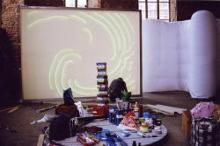
|
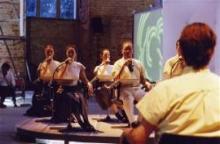
|
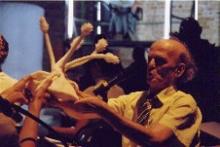
|
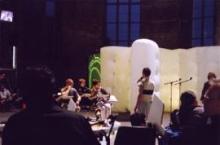
|
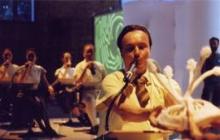
|
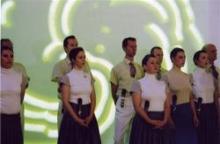
H.H.Diebner: Scenes from Einstein on the Beach, Parochialkirche Berlin 2005. |
Einstein on the Beach
In the years 2001 and 2005 we participated with Liquid Perceptron in new stagings
(directed by Berthold Schneider) of the opera Einstein on the Beach (Philip Glass und Robert Wilson). In the following I provide documentation on the second participation within the scope of Berthold Schneider's new production of the opera Einstein on the Beach by Philip Glass and Robert Wilson in the Parochialkirche in Berlin from 24 July to 5 August 2005. Director: Berthold Schneider; Curator: Ralf Hartmann; Music Director: Ari Benjamin Meyers; Orchestra: Redux Orchestra; Space Design: Veronika Witte; Choreography/Co-Director Jo Siska.
The images were taken during the setup period and premiere and show scenes from the opera as well as exhibits of the integrated visual media exhibition - including Liquid Perceptron.
Quote from staatsbankberlin: "The new production of 'Einstein on the Beach' at the staatsbankberlin takes as its basis the original artistic focus of Bob Wilson and Philip Glass and ventures to translate it into the aesthetic language of our times. For this reason, artists from the fields of photography, video, installation as well as professional scientists have been included in the production. Instead of a set-design these artists developed 'intervention strategies' which were realized in the actual performance-site. The installation assumed functions traditionally assigned to acting, costumes and set. This fusion of performance and applied arts brings to life the tremendous artistic impact of the original production in a contemporary visual environment".
The opera "Einstein on the Beach" by Robert Wilson and Philip Glass (WP 1976, Festival d'Avignon) counts to the most influential works of contemporary opera literature. After a stage suspension on the part of the authors, the opera has been shown the first time in August in Berlin by means of a new production in the "Staatsbank" under the musical direction by Ari Benjamin Meyers and stage direction by Berthold Schneider.
After the much-noticed Berlin premier 2001 in the former Staatsbank, the work could be experienced anew within the scope of the "Einsteinjahr 2005" with a new artistic concept again under the musical direction of Ari Benjamin Meyers in the Berlin Parochialkirche.
Exhibitions:
- TESTING GROUND Part of the symposium "Revolving Stars, Shaky Grounds: Constellations of Precarious Knowledge in Art, Science and Technology", Festspielhaus Hellerau Dresden, Forum / Workshops / Exhibition, 03.07 - 06.07.2014
- TRANSITION - knowledge through performance in art and science. Hanse-Wissenschaftskolleg Delmenhorst from 25.10.--30.11.2012.
- INM@Night of Museums in Frankfurt upon Main on Sat. 07 May 2011. On the occassion of the "Night of the Museums" all users of the cultural bunker at Schmickstraße 18 (cultural bunker in Frankfurt's East harbor) joint to organize a common programme for "The Night".
- New media make sense | Context INM: performative science and vireality An exhibition within the scope of "Forum Science and Art" of the HMWK-Hessian Ministery for Science and Art. Curated by Michael Klein and Hans H. Diebner, Institute for New Media, Frankfurt upon Main. Duration: 9 March - 16 April, 2011. Venue: HMWK Wiesbaden Rheinstr. 23-25. Vernissage: 8 March, 2011, 19.30h.
- Data Collision. An intermedia exhibition from 11 - 30 April, 2008, in the town gallery Nova Gorica, Slovenia.
- Participation in the exhibition within the scope of the new staging (directed by Berthold Schneider) of the opera Einstein on the Beach (Philip Glass and Robert Wilson) in the Parochialkirche in Berlin from 24 Juli to 5 August, 2005. Director: Berthold Schneider; Curator: Ralf Hartmann; Musical Director: Ari Benjamin Meyers; Orchestera: Redux Orchestra; Space Design: Veronika Witte; Choreography/Co-Director Jo Siska.
- Vision: Image and Perception, Budapest Autumn Festival- Mucsarnok/Kunsthalle Budapest - C3 18 October - 17 November 2002.
- Cibervisión 02: Fluid Dynamics. International Festival of Art, Science and Technology Cibervisión 2002 (Madrid, March 2002).
- Participation in the exhibition within the scope of the new staging (directed by Berthold Schneider) of the opera Einstein on the Beach (Philip Glass and Robert Wilson) in the Staatsbank Französische Strasse, Berlin, 22 to 31 August, 2001.
- K&S-Galerie Berlin, 2. Februar - 10. März 2001.